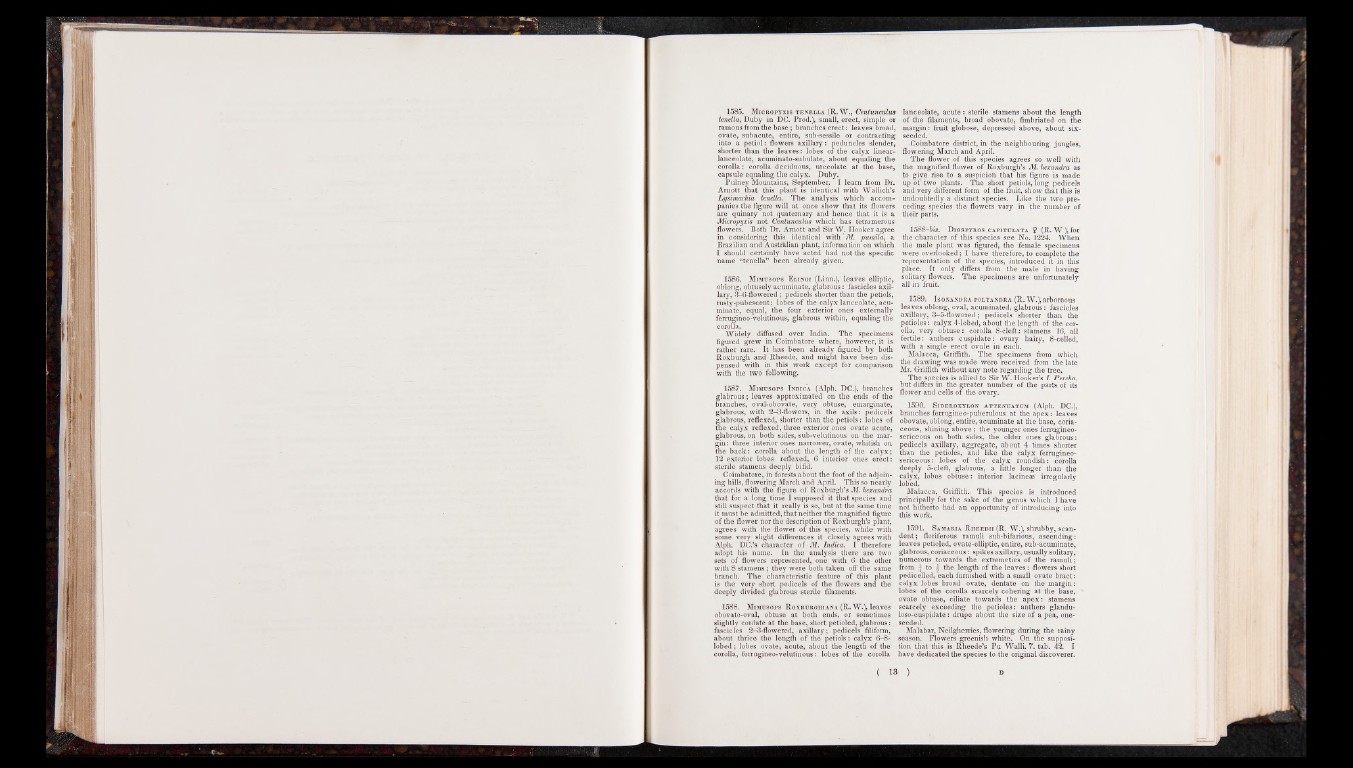
1585. Micropyxis tenella (R. W., Cenlunculus
tenella, Duby in DC. Prod.), small, erect, simple or
ramous from the base ; branches erect: leaves broad,
ovate, subacute, entire, sub-sessile or contracting
into a petiol: flowers axillary: peduncles slender,
shorter than the leaves: lobes of the calyx linear-
lanceolate, acuminato-subulate, about equaling the
corolla: corolla deciduous, urceolate at the base,
capsule equaling the calyx. Duby.
Pulney Mountains, September. I leam from Dr.
Arnott that this plant is identical with Wallich’s
Lysimachia tenella. The analysis which accompanies
the figure will at once show that its flowers
are quinary not quaternary and hence that it is a
Micropyxis not Cenlunculus which has tetramerous
flowers. Both Dr. Amott and Sir W. Hooker agree
in considering this identical with M. pumila, a
Brazilian and Australian plant, information on which
I should certainly have acted had not the specific
name “tenella” been already given.
1586. Mimusops Elingi (Linn.), leaves elliptic,
oblong, obtusely acuminate, glabrous: fascicles axillary,
3-6-flowered; pedicels shorter than the petiols,
rusty-pubescent: lobes of the calyx lanceolate, acuminate,
equal, the four exterior ones externally
ferrugineo-velutinous, glabrous within, equaling the
corolla.
Widely diffused over India. The specimens
figured grew in Coimbatore where, however, it is
rather rare. It has been already figured by both
Roxburgh and Rheede, and might have been dispensed
with in this work except for comparison
with the two following.
1587. Mimusops Indic'a (Alph. DC.), branches
glabrous; leaves approximated on the ends of the
branches, oval-obovate, very obtuse, emarginate,
glabrous, with 2-3-flowers, in the axils: pedicels
glabrous, reflexed, shorter than the petiols: lobes of
the calyx reflexed, three exterior ones ovate acute,
glabrous, on both sides, sub-velutinous on the margin:
three interior ones narrower, ovate, whitish on
the back: corolla about the length of the calyx;
12 exterior lobes reflexed, 6 interior ones erect:
sterile stamens deeply bifid.
Coimbatore, in forests about the foot of the adjoining
hills, flowering March and April. This so nearly
accords with the figure of Roxburgh’s M. hexandra
that for a long time I supposed it that species and
still suspect that it really is so, but at the same time
it must be admitted, that neither the magnified figure
of the flower nor the description of Roxburgh’s plant,
agrees with the flower of this species, while with
some very slight differences it closely agrees with
Alph. DC.’s character of • M. Indica. I therefore
adopt his name. In the analysis there are two
sets of flowers represented, one with 6 the other
with 8 stamens; they were both taken off the same
branch. The characteristic feature of this plant
is the very short pedicels of the flowers and the
deeply divided glabrous sterile filaments.
1588. Mimusops Roxburghiana (R. W.), leaves
obovato-oval, obtuse at both ends, or sometimes
slightly cordate at the base, short petioled, glabrous:
fascicles 2-3-flowered, axillary; pedicels filiform,
about thrice the length of the petiols: calyx 6- 8-
lobed; lobes ovate, acute, about the length of the
corolla, ferrugineo-velutinous: lobes of the corolla
lanceolate, acute: sterile stamens about the length
of the filaments, broad obovate, fimbriated on the
margin: fruit globose, depressed above, about six-
seeded.
Coimbatore district, in the neighbouring jungles,
flowering March and April.
The flower of this species agrees so well with
the magnified flower of Roxburgh’s M. hexandra as
to give rise to a suspicion that his figure is made
up of two plants. The short petiols, long pedicels
and very different form of the fruit, show that this is
undoubtedly a distinct species. Like the two preceding
species the flowers vary in the number of
their parts.
1588-bis. Diospyros capitulata 9 (R. W ), for
the character of this species see No. 1224. When
the male plant was figured, the female specimens
were overlooked; I have therefore, to complete the
representation of the species, introduced it in this
place. It only differs from the male in having
solitary flowers. The specimens are unfortunately
all in fruit.
1589. Isonandra polyandra (R. W.),arboreous
leaves oblong, oval, acuminated, glabrous: fascicles
axillary, 3-5-flowered; pedicels shorter than the
petioles: calyx 4-lobed, about the length of the corolla,
very obtuse: corolla 8-cleft: stamens 16, all
fertile: anthers cuspidate: ovary hairy, 8-celIed,
with a single erect ovule in each.
Malacca, Griffith. The specimens from which
the drawing was made were received from the late
Mr. Griffith without any note regarding the tree.
The species is allied to Sir W. Hooker’s I. Percha,
but differs in the greater number of the parts of its
flower and cells of the ovary.
1590. SlDEROXYLON ATTENUATUM (Alph. DC.),
branches ferrugineo-puberulous at the ap ex: leaves
obovate, oblong, entire, acuminate at the base, coriaceous,
shining above; the younger ones ferrugineo-
sericeous on both sides, the older ones glabrous:
pedicels axillary, aggregate, about 4 times shorter
than the petioles, and like the calyx ferrugineo-
sericeous: lobes of the calyx roundish: corolla
deeply 5-cleft, glabrous, a little longer than the
calyx, lobes obtuse: interior lacineaa irregularly
lobed.
Malacca, Griffith. This species is introduced
principally for the sake of the genus which I have
not hitherto had an opportunity of introducing into
this work.
1591. Samaria Rheedii (R. W.), shrubby, scan-
dent; floriferous ramuli sub-bifarious, ascending:
leaves petioled, ovate-elliptic, entire, sub-acuminate,
glabrous, coriaceous: spikes axillary, usually solitary,
numerous towards the extremeties of the ramuli;
from i to i the length of the leaves: flowers short
pedicelled, each furnished with a small ovate bract:
calyx lobes broad ovate, dentate on the margin:
lobes of the corolla scarcely cohering at the base, "
ovate obtuse, ciliate towards the apex: stamens
scarcely exceeding the petioles: anthers glandu-
loso-cuspidate: drupe about the size of a pea, one-
seeded.
Malabar, Neilgherries, flowering during the rainy
season. Flowers greenish white. On the supposition
that this is Rheede’s Pu. Walli. 7. tab. 42. I
have dedicated the species to the original discoverer.